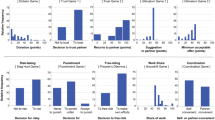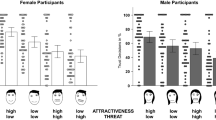Abstract
People tend to turn their left or right cheek to express or conceal emotions, respectively. We examined the lateral posing bias for displaying trustworthiness during a trust game in which participants and their virtual partners cooperated or did not cooperate with their counterparts to earn a monetary reward. Right-handed participants (N = 81) were asked to pose for a photograph and then play the trust game. Participants showed an overall left posing bias (i.e., showing their left cheek to the camera). The left cheek bias was more stable for participants that cooperated very little in the trust game (non-cooperators) than for those that cooperated a lot (cooperators). In the rating experiment (N = 28 and 25), non-cooperators showing their left cheek were rated equally as trustworthy as cooperators. On the other hand, non-cooperators who showed their right cheek were rated as less trustworthy than cooperators. These results suggest that non-cooperators intuitively use the left hemiface to exploit others in social interactions.



Similar content being viewed by others
References
Asian Face Image Database PF01 (2001). Intelligent Multimedia Lab, Pohang University of Science and Technology, Korea. Retrieved from http://imlab.postech.ac.kr/.
Borod, J. C., Koff, E., Yecker, S., Santschi, C., & Schmidt, J. M. (1998). Facial asymmetry during emotional expression: Gender, valence, and measurement technique. Neuropsychologia, 36, 1209–1215.
Brown, W. M., Palameta, B., & Moore, C. (2003). Are there non-verbal cues to commitment? An exploratory study using the zero-acquaintance video presentation paradigm. Evolutionary Psychology, 1, 42–69.
Butler, S. H., & Harvey, M. (2008). Effects of aging and exposure duration on perceptual biases in chimeric face processing. Cortex, 44, 665–672.
Chen, A. C., German, C., & Zaidel, D. W. (1997). Brain asymmetry and facial attractiveness: Facial beauty is not simply in the eye of the beholder. Neuropsychologia, 35, 471–476.
Churches, O., Callahan, R., Michalski, D., Brewer, N., Turner, E., Keage, H., et al. (2012). How academics face the world: A study of 5829 homepage pictures. PLoS One, 7, e38940.
Cosmides, L. (1989). The logic of social exchange: Has natural selection shaped how humans reason? Studies with the Wason selection task. Cognition, 31, 187–276.
Demaree, H. A., Everhart, D. E., Youngstrom, E. A., & Harrison, D. W. (2005). Brain lateralisation of emotional processing: Historical roots and a future incorporating ‘‘dominance’’. Behavioral and Cognitive Neuroscience Reviews, 4, 3–20.
Engell, A. D., Todorov, A., & Haxby, J. V. (2010). Common neural mechanisms for the evaluation of facial trustworthiness and emotional expressions as revealed by behavioral adaptation. Perception, 39, 931–941.
Frank, R. H., Gilovich, T., & Regan, D. T. (1993). Does studying economics inhibit cooperation? Journal of Economic Perspectives, 7, 159–171.
Fridlund, A. J. (1994). Human facial expression: An evolutionary view. San Diego, CA: Academic Press.
Fridlund, A. J., & Russell, J. A. (2006). The functions of facial expression: What’s in a face? In V. Manusov & M. L. Patterson (Eds.), Sage handbook of nonverbal communication (pp. 299–319). Thousand Oaks: Sage.
Gilbert, C., & Bakan, P. (1973). Visual asymmetry in perception of faces. Neuropsychologia, 11, 355–362.
Harris, C. D., & Lindell, A. K. (2011). The influence of autism-like traits on cheek biases for the expression and perception of happiness. Brain and Cognition, 77, 11–16.
Indersmitten, T., & Gur, R. (2003). Emotion processing in chimeric faces: Hemispheric asymmetries in expression and recognition of emotions. Journal of Neuroscience, 23, 3820–3825.
Kowner, R. (1995). Laterality in facial expressions and its effect on attributions of emotion and personality: A reconsideration. Neuropsychologia, 33, 539–559.
Levy, J., Heller, W., Banich, M., & Burton, L. A. (1983). Asymmetry of perception in free viewing of chimeric faces. Brain and Cognition, 2, 404–419.
Lindell, A. K. (2013). The silent social/emotional signals in left and right cheek poses: A literature review. Laterality, 18, 612–624.
McManus, I. C., & Humphrey, N. K. (1973). Turning the left cheek. Nature, 243, 271–272.
Nicholls, M. E. R., Clode, D., Lindell, A. K., & Wood, A. G. (2002). Which cheek to turn? The effect of gender and emotional expressivity on posing behaviour. Brain and Cognition, 48, 480–484.
Nicholls, M. E. R., Clode, D., Wood, S., & Wood, A. (1999). Laterality of expression in portraiture: Putting your best cheek forward. Proceedings of the Royal Society (Section B), 266, 1517–1522.
Nicholls, M. E. R., Ellis, B., Clement, J., & Yoshino, M. (2004). Detecting hemifacial asymmetries in emotional expression with 3-dimensional computerised image analysis. Proceedings of the Royal Society (Section B), 271, 663–668.
Nicholls, M., Thomas, N., Loetscher, T., & Grimshaw, G. (2013). The Flinders Handedness survey (FLANDERS): A brief measure of skilled hand preference. Cortex, 49, 2914–2926.
Oda, R., Yamagata, N., Yabiku, Y., & Matsumoto-Oda, A. (2009). Altruism can be assessed correctly based on impression. Human Nature, 20, 331–341.
Okubo, M., Ishikawa, K., & Kobayashi, A. (2013). No trust on the left side: Hemifacial asymmetries for trustworthiness and emotional expressions. Brain and Cognition, 82, 181–186.
Okubo, M., Kobayashi, A., & Ishikawa, K. (2012). A fake smile thwarts cheater detection. Journal of Nonverbal Behavior, 36, 217–225.
Okubo, M., Suzuki, H., & Nicholls, M. E. R. (2014). A Japanese version of the FLANDERS handedness questionnaire. Japanese Journal of Psychology, 85, 474–481.
Oosterhof, N. N., & Todorov, A. (2008). The functional basis of face evaluation. Proceedings of the National Academy of Sciences of the USA, 105, 11087–11092.
Oosterhof, N. N., & Todorov, A. (2009). Shared perceptual basis of emotional expressions and trustworthiness impressions from faces. Emotion, 9, 128–133.
Patten, J. (1996). Neurological differential diagnosis (2nd ed.). New York: Springer.
Rhodes, G., Morley, G., & Simmons, L. W. (2013). Women can judge sexual unfaithfulness from unfamiliar men’s faces. Biology Letters, 9, 20120908.
Sackeim, H. A., Gur, R. C., & Saucy, M. C. (1978). Emotions are expressed more intensely on the left side of the face. Science, 202, 434–436.
Sasson, N. J., Pinkham, A. E., Richard, J., Hughett, P., Gur, R. E., & Gur, R. C. (2010). Controlling for response biases clarifies sex and age differences in facial affect recognition. Journal of Nonverbal Behavior, 34, 207–221.
Stirrat, M., & Perrett, D. I. (2010). Valid facial cues to cooperation and trust: Male facial width and trustworthiness. Psychological Science, 21, 349–354.
ten Cate, C. (2002). Posing as professor: Laterality in posing orientation for portraits of scientists. Journal of Nonverbal Behavior, 25, 175–192.
Thomas, N. A. M., Burkitt, J., Patrick, R., & Elias, L. J. (2008). The lighter side of advertising: Investigating posing and lighting biases. Laterality, 13, 504–513.
Thomas, N. A. M., Loetscher, T., Clode, D., & Nicholls, M. (2012). Right-wing politicians prefer the emotional left. PLoS One, 7, e36552.
Todorov, A., Baron, S., & Oosterhof, N. N. (2008). Evaluating face trustworthiness: A model based approach. Social, Cognitive, & Affective Neuroscience, 3, 119–127.
Todorov, A., & Duchaine, B. (2008). Reading trustworthiness in faces without recognizing faces. Cognitive Neuropsychology, 25, 395–410.
Vauclair, J., & Donnot, J. (2005). Infant holding biases and their relations to hemispheric specializations for perceiving facial emotions. Neuropsychologia, 43, 564–571.
Verplaetse, J., Vanneste, S., & Braeckman, J. (2007). You can judge a book by its cover: The sequel. A kernel of evolutionary truth in predictive cheating detection. Evolution and Human Behavior, 28, 260–271.
Weatherill, R. P., Almerigi, J. B., Levendosky, A. A., Bogat, G. A., Von Eye, A., & Harris, L. J. (2004). Is maternal depression related to side of infant holding? International Journal of Behavioral Development, 28, 421–427.
Zaidel, D., Chen, A., & German, C. (1995). She is not a beauty even when she smiles: Possible evolutionary basis for a relationship between facial attractiveness and hemispheric specialization. Neuropsychologia, 33, 649–655.
Acknowledgments
This study was supported in part by KAKENHI (15K04190), and the MEXT-Supported Program for the Strategic Research Foundation at Private Universities 2011–2015 (S1101013).
Author information
Authors and Affiliations
Corresponding author
Rights and permissions
About this article
Cite this article
Okubo, M., Ishikawa, K., Kobayashi, A. et al. Can I Trust You? Laterality of Facial Trustworthiness in an Economic Game. J Nonverbal Behav 41, 21–34 (2017). https://doi.org/10.1007/s10919-016-0242-z
Published:
Issue Date:
DOI: https://doi.org/10.1007/s10919-016-0242-z




